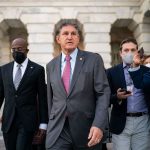Royal help has been enlisted.
In a furious dash to ensure a universal paid leave policy — however small — makes it into the final version of a care package weaving its way through Congress, the Democratic legislators who have advocated for the policy for years are trying everything — including working with the Duchess of Sussex.
Meghan recently called Sen. Kirsten Gillibrand of New York, who in 2013 proposed her own paid leave bill, and expressed her desire to help. Last month, Meghan wrote a letter to House Speaker Nancy Pelosi and Senate Leader Chuck Schumer as an “engaged citizen and parent” who recently gave birth to her second child, Lilibet Mountbatten-Windsor, with Prince Harry. Leave for their family was essential to provide the best care they could for their daughter, she wrote, but it’s a benefit most Americans go without.
“No family should have to choose between earning a living and having the freedom to take care of their child,” Meghan wrote, adding that for the United States to “continue to be exceptional, then we can’t be the exception” on paid leave. It is one of only a handful of nations that does not offer the benefit.
When Gillibrand and the duchess spoke, the senator offered to give her the numbers of her Republican colleagues, including Sens. Shelley Moore Capito of West Virginia, Susan Collins of Maine and others. They received direct calls from Meghan.
“I could hear how sincere she was about advocacy,” Gillibrand told The 19th.
Gillibrand said she plans to invite Meghan to Washington, D.C., for a bipartisan dinner she is hosting in the coming month with all the women senators, a tradition Vice President Kamala Harris restarted this year, to give her a platform to discuss paid leave. Gillibrand said Sen. Deb Fisher, a Republican from Nebraska, told her she is “delighted and looking forward to that conversation.”
Working with Meghan on advocacy is one piece of a larger concerted effort that has largely been focused on helping to bring Sen. Joe Manchin, the most vocal holdout on paid leave, on board with some version of the proposal that this week is back in contention after seeming all but dead in the water just a week ago.
Initially, the Democrats’ massive domestic policy package included a 12-week universal paid leave provision that would cover up to 80 percent of wages for the lowest earners, bringing the United States more in line with the rest of the world. Workers would be reimbursed for at least two-thirds of their pay up to a maximum of $4,000 a month.
The Democrats’ proposal needs the support of nearly every Democrat in the House and all Democrats in the Senate, including Manchin, whose concerns about how the policy would be funded ultimately led to its exclusion from the $1.75 trillion package.
Because President Joe Biden has vowed to not raise taxes on low- and middle-income Americans, the paid leave proposal would have been paid through raising taxes on the richest Americans. Nine states and Washington, D.C., already offer paid leave, but most do it through a payroll tax and an employer contribution, a combination that creates a fund similar to disability insurance that employees can tap into when they need it.
Manchin opposed the idea of funding it through general revenue, arguing there was not a specific funding stream, and supported an employee-employer match system instead.
That opposition was enough to strip paid leave from the plan entirely last week. But then on Wednesday, a new paid leave proposal surfaced. House Democrats included a version of the initial plan in their version of the package, cutting down the paid leave provision to four weeks instead of 12.
The new proposal provides leave for the birth of a new child, adoption, to care for an ailing family member, or for personal illness. It excludes leave for bereavement, which was initially part of the plan.
It does, however, retain a broad definition of family that is different from what other countries offer, including extended family and friends who are close enough to serve as the “equivalent” of family.
Full- and part-time workers, as well as self-employed workers, would be covered. The new plan also shifts how much of workers’ salaries are repaid so that the lowest earners get more coverage and the highest earners get less than what was initially proposed.
Those earning less than $290 a week (about $15,000 annually) would see 90 percent of their pay covered. Those earning about $1,200 a week, or $62,000 annually, would have about half of their pay covered. Benefits would begin to roll out in 2024.
Dawn Huckelbridge, the director of Paid Leave for All, a national advocacy organization pushing for federal paid family and medical leave, said four weeks is far from what advocates initially wanted. Twelve weeks is at the lowest end of what medical groups consider to be the ideal time frame of leave that is most beneficial to parents and babies, without impacting workforce mobility.
Four weeks, too, is sooner than most child care centers will accept infants. Most will not take infants until they are about six to eight weeks old, a burden that will fall heaviest on mothers, who are the most likely to leave their jobs to care for children. Still, Huckelbridge said it is a starting point.
“There have been real compromises made,” Huckelbridge said. “But to the majority of Americans who don’t have a single day of guaranteed paid leave, [four weeks] will still be transformational.”
About 95 percent of the lowest-paid workers in the country, most of them women, don’t have paid family leave and 67 percent of those workers don’t get paid sick leave.
The package that Democrats are putting forth could include investments in three key areas that could have a transformational impact on women and mothers, in particular. A historic investment in child care would raise wages for child care workers — 95 percent of them women — lower costs so many parents pay up to 7 percent of their income on care and no more, and increase the supply of child care so families can more readily access the service, which has a direct correlation with how much parents can engage with the workforce. It would also create the country’s first universal preschool program for 3- and 4-year-olds — completely free to families.
But without paid leave, advocates argue, families are not covered during the earliest years of their children’s lives.
“Paid leave is an issue that carries you throughout the lifespan, from welcoming a new child to holding the hand of a dying parent,” Huckelbridge said. “Those care issues are meant to be three legs of the stool and if you cut one of them off, American families are the ones that will fall.”
Still, what is on the table now will fall short of providing full access and equity. The paid leave plan doesn’t include a job protection provision, for example, meaning there is no anti-retaliation provision that protects workers who seek to take leave. Research by the Department of Labor and in states like California, which has its own paid leave policy, has found that workers who are eligible for paid leave will forgo it if there is no job protection attached.
Jocelyn Frye, the incoming president of the National Partnership for Women & Families, a group that has been advocating for paid leave for three decades, said that though the proposal on the table falls short of equity markers, it does meet some objectives and could be expanded on.
“For me, the question is: Will this give people benefits that they do not have?” Frye said. “The truth of the matter is there are people who need protections today. The people who are likely to benefit the most are disproportionately low-income and women of color.”
But to even get there, the bill still needs to get enough support in the Senate, and Manchin is a key hurdle. Huckelbridge pointed out that the senator has opposed other elements of the plan, like the expanded child tax credit, then ultimately stood down.
Gillibrand, meanwhile, is working another angle.
Manchin’s vision of a paid leave program that employees and employers both pay into is similar to her original vision in the bill she co-authored with Rep. Rosa DeLauro in 2013. Manchin wants to break off paid leave from the current package and try to pass it on its own with bipartisan support he said believes he can obtain.
But, Frye said, that option has been available for nearly a decade, and it’s never been able to get bipartisan support.
“It is inaccurate to suggest that there has not been ample opportunity to have a conversation about how you could move a paid leave bill forward using that structure,” she said. “It is simply not accurate to say this is a new idea or a new moment where we can focus on it.”
Gillibrand said that based on conversations she’s had, Republicans likely won’t support that plan right now. Instead, she thinks she can work with Manchin to get closer to his version of paid leave in the next few years.
She hopes “he fully understands that [Republicans are] not with us on universal coverage today, and they’re not with us on an employer-employee match,” which could help him support the House proposal as a starting point. She then envisions a system where they work with states to create regional paid leave funds, similar to what he is proposing. Small states could band with larger states to pool their resources into one fund that employees in that region could tap into.
“[Then] he and I will work with our Republican friends long-term to get to the full 12 weeks, fully sustainable, fully paid-for employer-employee match system that could maybe be crafted long term through the states,” Gillibrand said.
The idea is to bring people to the table by first passing the House version, she said. Then perhaps employers can fill in extra weeks to help families who can’t yet get their kids in child care, for example.
“It creates the possibility of greater generosity and businesses meeting us halfway,” she said. “So that’s the case I’m going to make to Sen. Manchin over the days to come together to get everyone to ‘yes.’”








